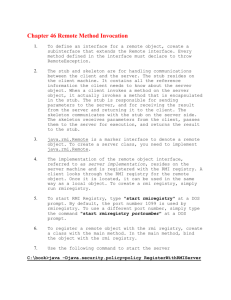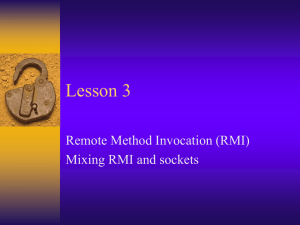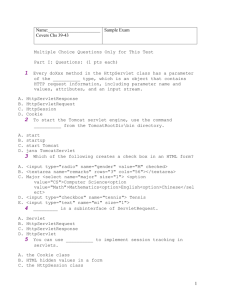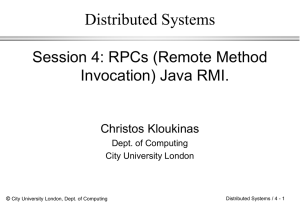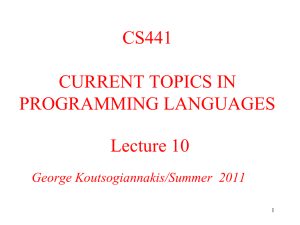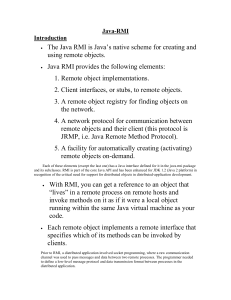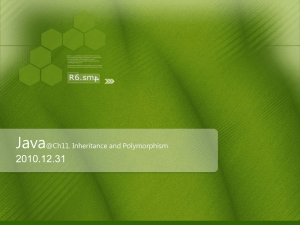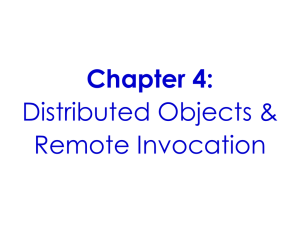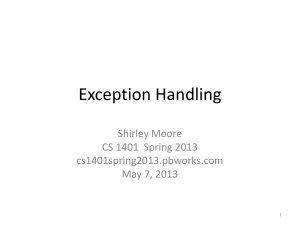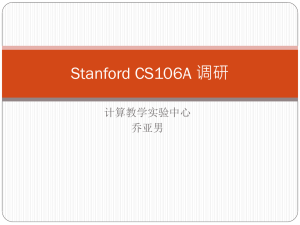Remote Method Invocation(RMI)
advertisement
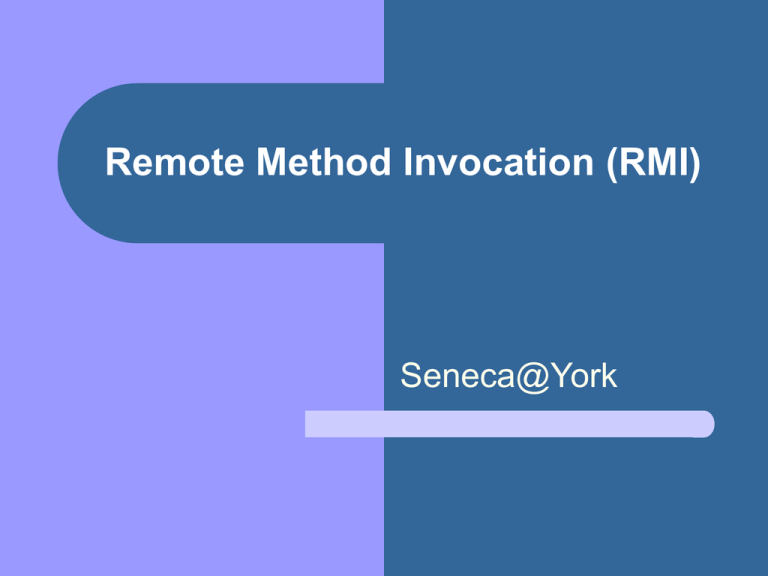
Remote Method Invocation (RMI) Seneca@York What is a distributed application? a stand-alone Java application - all Java objects reside on ONE computer - example: ProductApplication.java a distributed application - What if the Java objects are created on another computer? - How can a Java program running on a different computer use these Java objects? What is a distributed application? a distributed Java application - remote Java objects reside on DIFFERENT computers, connected by the Internet - application development questions: - how to use these remote objects? - how to create the remote objects? - solutions - use of socket-based client/server programming model - use of RMI The Limitation of Using Java Sockets the complexity of coding application-level protocols (for encoding and decoding messages for exchange) - time-consuming - error-prone Java-to-Java Distributed Applications a distributed application is split across the client and the server RMI: Java support for distributing objects across multiple computers – – Java objects run on different computers over the Internet Java objects communicate with one another via remote method calls Remote Method Invocation (RMI) a Java-based distributed programming model “making remote methods calls across the network” a technology for creating and using distributed Java objects (i.e. Java objects that are spread over the network) - invocation of Java methods on remote objects Remote Method Invocation (RMI) an abstraction of network communication - network communication is transparent to a Java programmer - a Java programmer does not write any code to handle remote method calls and data communication Remote Method Invocation (RMI) a remote object / a server object is created and registered on a server a client object uses a remote object by obtaining a remote reference to the object and making remote method calls seamless integration: same Java syntax and semantics as in non-distributed Java applications Building RMI Applications 1. 2. 3. 4. develop the “Remote” interface of a remote object (i.e. declarations of remote methods) - shared by the client and the server develop the remote object implementation of the “Remote” interface (server-side programming) develop a Java application to bind the remote object to the RMI registry (server-side programming) develop a client application that uses remote objects Example 1 interface: Product implementation: ProductImpl.java server application: ProductServer.java client application: ProductClient.java demo: localhost Key RMI Programming Concept remote service = a remote interface + an implementation - a client object uses a remote interface - a server (JVM) runs the implementation ( i.e. provides the remote service) - a stub class: a proxy for the remote service and runs on the client (JVM) Running an RMI Application: the server side compile the remote object implementation javac ProductImpl.java generate the stub class (v 1.2 and above) rmic -v1.2 ProductImpl compile the Java application that registers a remote object javac ProductServer.java Running an RMI Application: the server side start the RMI registry ** rmiregistry 6666 ** Run the command in the directory that contains the class files. The default port number is 1099. run the Java application java ProudctServer Running an RMI Application: the client side compile the client application javac ProductClient.java run the client application * java ProductClient * the stub class must be available locally or loaded remotely Developing A Remote Interface a declaration of remote methods the Remote interface: a tagging interface the method arguments and the return values must be “serializable” - checked at run time Remote Object Implementation a subclass of UnicastRemoteObject - an abstraction of communication details an implementation of a “remote” interface the constructor “exports” a remote object the RemoteException - a superclass of all exceptions that can occur in the RMI run time Locating/Naming Remote Objects Question: How does a client object locate an RMI remote object ? Answer: Use a naming or directory service that runs on a host (i.e. server machine) and a port number (default: 1099). the RMI registry - an RMI naming service - a remote object that serves as a directory service for the client objects - java.rmi.registry.Registry Locating/Naming Remote Objects the java.rmi.Naming class the server side - create a local object that implements a remote service - register the object with the RMI registry - rebind( ) * * a thread is started to listen for a client request Locating/Naming Remote Objects the syntax of an RMI object URL rmi://<host_name> [:<service_port_number] /<remote_service_name> e.g. “rmi://odin.senecac.on.ca:7890/store” Locating/Naming Remote Objects the client side - use an URL to access the RMI registry on a host and obtain a remote reference to a remote object - lookup( ) Case Study: Remote Registration Service remote student registration services - register a course - drop a course - find out the number of credits registered - get all the courses registered - get a student name - get student information Note: Each student has a unique student id. Declaration of Remote Method Calls public String getName( String id ) throws RemoteException; public int getCredits( String id ) throws RemoteException; public boolean addCourse( Course c, String id ) throws RemoteException; public Course dropCourse( String courseCode, String id ) throws RemoteException; public Course[ ] getCourses( String id ) throws RemoteException; public Student getStudent( String id ) throws RemoteException; Question: How are Course and Student objects passed by RMI? Implementation of Remote Method Calls remote interface: StudentRegistration implementation: StudentRegImpl two other classes: Course, Student * * serializable server application: RegistrationServer client application: RegistrationClient demo - remote service on the iSeries server - two thin clients on the desktop RMI Architecture Layers the “invisible parts” of RMI technology 3 abstraction layers - the Stub and Skeleton layer - the Remote Reference layer - the Transport layer RMI Architecture Layers Client Object Server Object Stubs / Proxies Stubs & Skeletons Remote Reference Layer Remote Reference Layer Transport Layer Transport Layer The Stub and Skeleton Layer the interface between an RMI application and the RMI system: RMI client RMI server the stub: a client-side proxy (i.e. an object that acts on behalf of the remote server object) – – intercept remote method calls made by a client redirect the calls to a remote RMI service (via the Remote Reference layer) The Stub and Skeleton Layer the stub – – marshall remote method arguments unmarshall return values the skeleton (a mirror image of the stub): a server-side proxy – – – unmarshall remote method arguments direct the method calls to the actual server objects marshall return values and exceptions back to the client-side stub (via the Remote Reference layer) The Remote Reference Layer connect client objects to remote objects by a one-to-one connection link - Java 2 supports Remote Object Activation support the invocation semantics of the RMI connection The Transport Layer make stream-based network connections over TCP/IP between the client-side JVM and the server-side JVM The RMI Method Invocation Mechanism 1. 2. The RMI server object is registered with an RMIRegistry server (that operates at the transport layer). The RMI client finds the remote server object through the RMIRegistry (at the remote reference layer) and receives a stub object (on behalf of the remote object). The RMI Method Invocation Mechanism 3. 4. 5. 6. The RMI client invokes methods on a remote object. These invocations are handled by the stub object. The remote method arguments are marshalled and sent across the network. The remote method call is initiated through the stub object. The remote method call is dispatched to the server-side skeleton object. The RMI Method Invocation Mechanism 7. 8. 9. 10. 11. The remote method arguments are unmarshalled on the server side. The remote method call is invoked on the actual server-side object. Return values are marshalled by the server-side skeleton object. Return values are sent to the client-side stub object. Return values are unmarshalled by the client-side stub object and passed upward to the caller. Parameters in RMI Question: How does RMI transfer parameters (and return values) between the client JVM and the server JVM? Answer: Use object serialization! ** ** for a Remote object - a remote reference for the object is generated, marshalled and sent over the network (i.e. a stub object) - the actual Remote object is NOT copied FAQ 1. 2. Q: Can we find out all the service names that have been registered with the RMI Registry? A: Yes. java.rmi.Naming.list( “odin.senecac.on.ca” ) Q: Does RMI have built-in synchronization mechanism for remote method calls? A: No. One has to declare those methods as synchronized. FAQ 3. Q: Can we use one RMI Registry to run two RMI servers? A: Yes. Put all the server code in one subdirectory. Resourceful Link Java Tutorial on RMI
